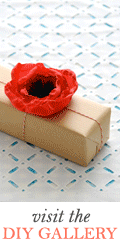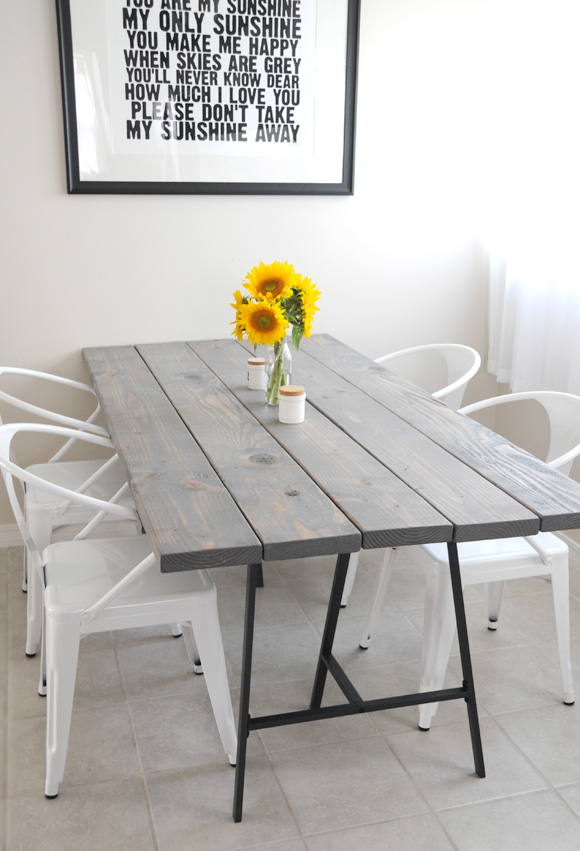
A couple weeks ago I posted an instagram snapshot of a quick little DIY Geometric Gem Clay Mobile that I'd made with the clay I had leftover from my DIY Clay Nursery Mobile project, and offered to share a tutorial if anyone was interested. Since several of you were, I've put together a quick step-by-step guide so that you can easily make your own. The process and techniques are almost the same as my previous DIY, so I'll be referring to that for most of the project. Grab you're supplies and let's start crafting!

Supplies needed:
- Rolling pin (the non-stick variety is preferable)
- Premier Stone Clay - available at craft stores such as Michael's or online
- Elmer's Paper Craft Gel Glue
- Metallic Pen-Touch Paint Pen by Sakura (extra fine point) | available at craft supply stores
- Craft knife
- Twine
- Freezer paper or waxed paper (to protect your work surface)
- Scissors (optional)

Cover a smooth hard working area with a piece of waxed or freezer paper (freezer paper, waxed side up works the best). Use your rolling pin to flatten your clay into a smooth disk. The finished piece should be rolled to about 1/4 inch thick. Use your craft knife to carefully cut triangular shapes into your clay (you do not need to cut all the way through). You can make this process more efficient by cutting multiple triangles on each rolled disk of clay (as seen demonstrated in the image above).

Now cut away the outside edges and separate each triangle from one another. Cut off the two corners at the wide end of the triangle (shown above). You can make the angle of these cuts as deep or as shallow as you'd like.

Dab your finger into a bit of water and smooth it along the edges of your shape. You can smooth the front and back as well. Use a bamboo skewer to make a small hole at the top of your geometric gem shape.
Make as many gems in as many different sizes as you'd like. For my mobile I used eight gems in a variety of sizes from small (around 3/4") to large (around 2").
Allow your gems to dry completely (24 hours is optimal). You may need to prop them up on their side against something so that air can circulate around them.

Once your gems are dry, you can add detail to them using a metallic paint pen. The following are the steps I used on mine, but you can draw inside your shapes however you'd like.
First start by drawing around the inner outline of your shape. then draw two short lines angled downward from the lower points on your gem shape.

Connect those two lines with a straight line across the middle. Where the first two downward angled lines ended, draw two long lines down until they meet at the narrow point of your gem.

Draw two short lines angled upward and out from where your last two lines started. Finish the design by drawing three straight lines within the upper portion of your shape...these should mirror the first three lines that you drew.

Hooray! Your gem is complete. Now you can draw the same design on the backside and repeat this process with all remaining gems.

To assemble your mobile place a small dot of glue into the hole at the top of your gem. Knot the end of a piece of twine and place the knotted end inside the hole. Use your bamboo skewer to press in and ensure that that the twine is fully embedded inside the hole. Lay your glued piece aside and repeat process with all remaining gems.
Tip: I kept all my twine portions long (around 26 inches each) until the very end so that I had the ability to arrange them at different lengths depending upon how they looked when strung together.

Once the glue has dried, arrange the gems in whatever order you'd like and tie all twine portions together in one knot to secure. Snip off any uneven ends.

Hang your gem mobile on a nail or with a piece of Japanese making tape!

Bonus idea: Pierce a small hole through the top of a clay gem while it is still soft. Once dry you can use it to embellish a gift. Just string the gem onto a piece of twine or ribbon and you're done, tie it to your present and you're done!
I hope you liked this sweet and simple project. If you want more, I invite you to check out all my past Creature Comforts' DIY projects right here. xo Ez
 Several weeks ago I ordered a copy of the new Heather Ross Prints book. I eagerly awaited its arrival and no sooner had it hit my doorstep than it was unwrapped from its box and voraciously flipped through. The book features an extensive number of awesome DIY projects using Heather Ross' patterns in applications from wallpaper, and sewn crafts, to printables (yes there is a disc included with all the patterns and printables she uses). It's truly worth its weight in gold!. But what truly sold me was the portion of the book where Heather shares her design process, and gives a thorough Photoshop tutorial for those who are interested in learning. I literally could not wait to try!
Several weeks ago I ordered a copy of the new Heather Ross Prints book. I eagerly awaited its arrival and no sooner had it hit my doorstep than it was unwrapped from its box and voraciously flipped through. The book features an extensive number of awesome DIY projects using Heather Ross' patterns in applications from wallpaper, and sewn crafts, to printables (yes there is a disc included with all the patterns and printables she uses). It's truly worth its weight in gold!. But what truly sold me was the portion of the book where Heather shares her design process, and gives a thorough Photoshop tutorial for those who are interested in learning. I literally could not wait to try!
 Here's what I made. I first decided on a magic show theme, and after sketching up some ideas I followed each step in the book carefully (from raw sketching to Photoshop editing) until finally by the end of the day I had created my very own print!
Here's what I made. I first decided on a magic show theme, and after sketching up some ideas I followed each step in the book carefully (from raw sketching to Photoshop editing) until finally by the end of the day I had created my very own print!


 33 Lovely Comments |
33 Lovely Comments |  Email Article | found in
Email Article | found in  About Me / My Shops,
About Me / My Shops,  D.I.Y. + Projects,
D.I.Y. + Projects,  Magazines + Books
Magazines + Books  Print Article | |
Print Article | |  | by
| by  Ez
Ez  Tuesday, September 25, 2012
Tuesday, September 25, 2012 










 In the Photojojo newsletter this morning, they shared this sweet little project for making your own
In the Photojojo newsletter this morning, they shared this sweet little project for making your own 























